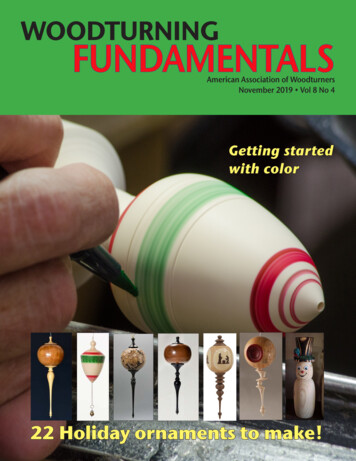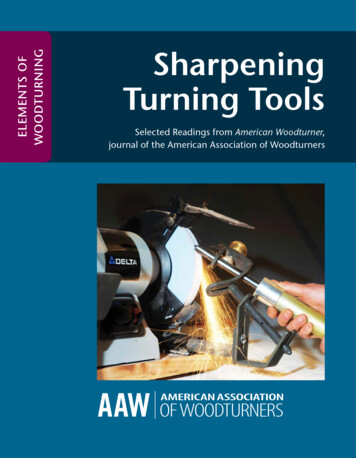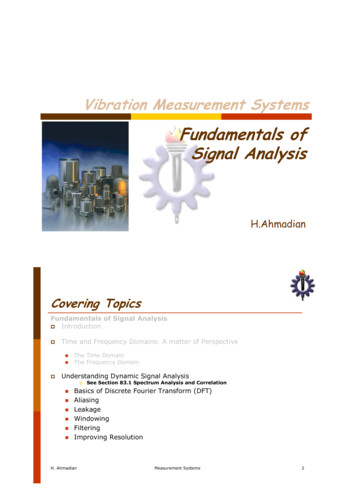
Transcription
WOODTURNINGFUNDAMENTALSAmerican Association of WoodturnersNovember 2019 Vol 8 No 4Getting startedwith color22 Holiday ornaments to make!
WOODTURNINGFUNdamentalsNovember 20194Vol. 8 No. 4Greetings and farewellAAW teachers share holiday projectsHoliday projects f ill Santa ’s sack5Pyrography decorates poplar ball6Chain finial makes quick ornaments9No-hollowing hollow ball-and-finial11Fancy ornaments with glued-on sides12Hollow Ball with Glued Finials16Hollow ball with contrasting inserts18Snow-persons for beginners21Fencepost snowman23Post dyed green is popular Christmas tree24Birdhouse ornament28Birdcage ornament33Multi-axis turkey toothpick holder37Kids love pull-string spinning top41Lidded box makes a personal gift45Finishing: Getting started with color48Happy colors for happy holidaysCover: John Lucasapplies marker colorto solid-wood chainfinial ornament,page 6 and 45.Woodturning FUNdamentals November 20192 American Association of Woodturners woodturner.org
WOODTURNINGFUNdamentalsWoodturning FUNdamentalsis published by theAmerican Association of Woodturners222 Landmark Center75 5th Street W.St. Paul, MN 55102-7704651-484-9094Toll free: Executive DirectorPhil McDonaldphil@woodturner.orgProgram DirectorLinda Ferberlinda@woodturner.orgGallery CuratorTib ShawGallery Websitegalleryofwoodart.orgMarketing & CommunicationsKim Rymerkim@woodturner.orgBoard of DirectorsGregory Schramek, PresidentJeff Brockett, VPKathleen Duncan, SecretaryJoe Dickey, TreasurerRick BakerAndy ColeDavid HeimJanet A. CollinsKen LedeenEditor, FUNdamentalsJohn Kelseyeditorkelsey@woodturner.orgAssociate EditorsLinda FerberDon McIvorEditor, American WoodturnerJoshua FriendThe AAW strives to cultivate an organization builton mentorship, encouragement, tolerance, andmutual respect, thereby engendering a welcomingenvironment for all. For more, tiny.cc/AAWDiversity.Woodturning FUNdamentals November 20193 American Association of Woodturners woodturner.org
GREETINGS. and farewellAAW teachersshare projectsfor holidaysmyself. I particularlyenjoyed Carol Hall’seasy approach to color,page 45, and LarryHasiak’s no-hollowingapproach to making ahollow ball-and-finial,page 9. Larry’s methodmakes the whole thingfrom one billet, maybesimpler and quickerthan separately turningfinials to glue on.We’re delighted to deliver this project-filledissue of Woodturning FUNdamentals. All of theholiday projects in this issue came from theAAW’s Demonstrator Direct service. Back inAugust, we emailed a select group of these finefolks to ask for holiday projects they use whiledemonstrating and teaching. As you’ll see, wereceived a Santa sack full of great ideas.The photo shows my own efforts, turnedfrom local black cherry. They’re hollowand light enough, but my finials, so clumsyalongside the beauties on pages 5, 15 and48. No biggie though; I’ll get better at it, andthe finials perhaps a bit more graceful, aftera dozen repetitions for my gift list. AlmostThanksgiving, gotta get started!As usual while assembling each issue ofFUNdamentals, I tried a few of the projectsAbout that baton.But all good things do end. After this issue I’mreturning to joyful retirement and my ownworkshop. I’m deeply grateful to Josh Friend,editor of American Woodworker, Phil McDonaldand the AAW office staff, and all of the boardmembers I’ve worked with.Well my whole career has been a bit liketurning multiples. I’ve been writing, editing,and publishing magazines and books aboutwoodworking and turning, ever since 1975.Coming up on 45 years, egad. Create and gatherthe material for each edition, get it all cleanedup nice and out the door on time, whew. Thendo it again. And again. Each time around, try towrite more clearly, take sharper photos, managemore details, deliver more value to readers.That’s the routine we taught ourselves at FineWoodworking magazine 45 years ago, and that’sbeen my two years as editor of WoodturningFUNdamentals. Eight hefty issues, almost 400pages.Don McIvor, woodturner-editor from Twisp,WA, editormcivor@woodturner.org, will pick upthe baton and go forward. We’ve been workingtogether on this issue, and I’ll leave it to Don tointroduce himself in the February 2020 editionof Woodturning FUNdamentals.With all best wishes,John Kelsey, Lancaster PAIt’s been a huge pleasure for me to come out ofretirement to manage AAW’s digital quarterly.It’s given me new opportunities to meet somany skilled turners and devoted teachers. Andhere’s my secret sauce: while I work with themto shepherd their ideas and information intoprint, I also soak it up for myself, to use in myown workshop. Big fun!Woodturning FUNdamentals November 2019tiny.cc/JohnKelsey4Explore!Click the blue box orscan the QR code tofollow the link .but it only workswhen you arealso logged intothe AAW website,woodturner.org American Association of Woodturners woodturner.org
TE CHNIQUEPyrographydecoratespoplar ballby Janice LeviI am a fan of simplicity in the finial (which Ithink should complement the globe) whilemaking the globe the primary feature of theoverall ornament. This globe is made of poplarwhile the finials are African blackwood. I oftenchoose the somewhat soft poplar if my planis to use pyrography to enhance the globe.Following are a few of the steps:Turn the globe approximately 2” (5cm) indiameter with a 1/2” (12mm) hole drilled allthe way through.Loosely dividing into thirds, the bottomfinial will be about 4” (10cm) long with a1/2” (12mm) tenon. I go further and dividethe finial itself into thirds with the bottomtwo-thirds being fairly void of design whilethe top one-third flows out to allow the eyeto be drawn into the globe.The top finial is about 1” (2.5cm) in heightand the turned elements will be similar indesign to the elements in the lower finial.Using a ball writing tip, I outline the majorelements. To give depth to the designs, I varythe temperature of the woodburner to simulatehighlights and shadow.This particular ornament is a study in black andwhite—no color. All the woodburned surfaceswere accomplished by varying the temperatureof the burner. The embellishment was appliedbefore gluing the finials to the ornament.With all the major elements burned, I use thesame ball tip to stipple the background darkblack.I drew the design onto the globe in pencil. Ido occasionally use patterns that are availableonline and in woodburning books but I usuallyprefer to draw straight onto the wood. I alwayswork on raw wood sanded to 320 or 400 grit.Woodturning FUNdamentals November 2019After burning and assembly, I apply a sprayfinish (usually acrylic) to the entire ornament.Janice Levi discusses finial design in the October2019 issue of American Woodturner. She is afrequent demonstrator and teacher, janicelevi.com.5 American Association of Woodturners woodturner.org
PROJE C TChain finialmakes quickornamentsby John LucasI make a lot of ornaments. I donate manyof them to our club to raise money for localcharities. I’ve done a lot of hollowed sphereswith finials and a lot of single-piece ornaments.I was looking for something that would be veryquick to make but was a step above a simplesolid ball, and would sell for a few dollars more.Finials are always slow to make, but what aboutusing chain instead of wood? It worked great,they are very popular, and sell fast.1. Roughing the blank1. Roughing the blank — Start with a 6”(15cm) piece of wood about 1-1/2” to 2” (5cm)in diameter. If I’m going to do a lot of coloringI use woods that don’t have a strong grainpattern, and light-colored woods like holly. Istart between centers and turn it round, andthen cut a tenon to fit the scroll chuck.2. Turning the shape — Put it in the chuckand simply turn a shape. Since these are so fastto make and do not require hollowing, I playwith the shapes a lot. You can really explore oneshape and try to nail the perfect curve.2. Turning the shape3. Drilling for chain — Leave the upperportion fairly thick but turn the bottom endto a point. Then I use the skew on its side tocut a starter hole for the drill. I bore about 1/2”(12mm) deep with a 7/64” bit, which fits mychain. Now I sand the piece to prepare it fortexturing.3. Drilling for chainWoodturning FUNdamentals November 20196 American Association of Woodturners woodturner.org
PROJE C T: Ornament with chain finial4. Texturing tool5. Mini spiral tool6. Elf-type tool4, 5, 6. Texturing toolsI like Tombow or Calligraphybrand markers, but Sharpiesalso work. Ideally you wantarchival inks so the colorswon’t fade.the turning while it’s spinningat a slow speed. It’s almostmagical and it makes a nicecolored ring.8. Crisp lines — To getreally crisp lines I prefer to usea paintbrush and calligraphyinks. This came from my earlyarchery arrow-making days.The calligraphy ink comesalready mixed to the rightconsistency. It’s easy to makenarrow or wide bands of colorwith crisp edges using thistechnique. Just dip the brushin the ink and gently touchAfter texturing and paintingit is time to finish turning thetop of the ornament. I turnit down fairly small and thenbring up the tailstock to justbarely touch the drilled hole.This extra support lets me sandand polish aggressively. ThenI gently cut off the ornamentand polish the last bit on top.I think the ornaments lookbest with just one or twotextured bands. I use theSorby texturing tool, the miniSorby with a spiraling cutter,the Henry Taylor Elf, and myshopmade chatter tool.7. Coloring — I like tocolor the texture to make itstand out, and the colors arebrighter when applied over afinish. Finishes applied on topdull the colors, and may causethe colors to run. So I applya friction finish now, beforecoloring. I use Hut Pen Polish.9. Turning the finial 7. Coloring8. Crisp linesWoodturning FUNdamentals November 201979. Turning the finial American Association of Woodturners woodturner.org
PROJE C T: Ornament with chain finial10. Wooden bangle11. Stiffening the chain10. Wooden banglethese things?” The solutionis to make about 1/4” to 3/8”(6-10mm) of the chain rigid,using medium CA. Just start iton the chain and drag the dropon down. Then spray with CAaccelerator and let dry.Crosses are popular atChristmas, but sometimes Imake a wooden bangle, ratherthan store-bought jewelry,using the scrap left on thelathe. Start by drilling thechain hole. Then turn theshape you want, sand it andcut it off.Now to apply polish, Imount the drill chuck in theheadstock with a broken 7/64”bit as a mandrel. This is a veryshort drill, it won’t bend underpressure. Mount the small topfinial on the drill bit and applyfriction polish. It takes a gentletouch to keep the banglefrom stalling but it’s doable.If the friction polish is toochallenging try a CA finish.11. Stiffening the chainIt can be very frustrating to getthe chain in the hole. Remindsme of an old joke, the city manis driving down the road andsees a country man dragginga chain, so he asks, “Why areyou dragging that chain?”The country man says, “Haveyou ever tried to push one ofNow you have a stiff chainthat goes in the hole veryeasily, and if a ball of glueinterferes, just squeeze it withpliers. Once you know it fits,apply a few drops of CA in thehole and push the chain in.Let it dry.12. Add the bangleAttach whatever bangle youwant to the free end of thechain. You may need to buysome jump rings, or split rings,to attach a jewelry piece. Forthe top I use eye pins that arein the jewelry-making sectionof the craft shop. I cut themto length and drill the propersize hole using my Dremel.Then simply glue them in withmedium CA.That’s all there is to it. Theseare so fun to make. I madeten of them yesterday whileWoodturning FUNdamentals November 2019812 . Add the banglepreparing this article. As theday progressed I got faster,the last one took me only 15minutes. So if I were sellingthem they would be quiteprofitable. I will be makingmany more to contribute toour tree. I hope you will too.John Lucas is a retired photographerliving in Cookeville, TN. He hasbeen turning wood for 35 years; hisfavorite items are hand mirrors andChristmas ornaments. John is afrequent contributor to WoodturningFUNdamentals. American Association of Woodturners woodturner.org
PROJE C TNo-hollowingtechniquefor hollowball-and-finialby Larry HasiakOne distant Christmas past I made some onepiece solid-wood tree ornaments. They wereso heavy they wouldn’t stay on the slendertree branchlets. To make them lighter I foundan easy way to hollow the balls. I turned therough shape of a Christmas ball, cut it in half,scooped out the two halves, and glued themback together.Part, hollow and glue – Colorwood ball wasparted along the central burn line so the halves couldbe hollowed like two small bowls, then it was gluedback together. Integral finial was turned last.The blankStart with a blank 2-1/2 to3” (6-7cm) square by about6” (15cm) long. You can usealmost any kind of wood — I’vebeen enjoying colored woodslaid up in holiday themes.Mount the blank betweencenters, make a cylinder andcut a chucking tenon on oneend. Now mount the blankin your scroll chuck, bringingup the tailstock for additionalsupport.Next, cut a tenon on thetailstock end, so that later youcan remount that portion1. Round the ball after2. Reference line across theof the parted blank forhollowing. The tailstock endwill become the top of theornament, so turn a roughball shape (1) closer to thetailstock than to the chuck.Stop the lathe. Draw a lineacross the ball at the highpoint (2), to give you areference for regluing later.making a second chucking tenonon the tailstock end.high point will help reassemblethe ball later. Woodturning FUNdamentals November 20199 American Association of Woodturners woodturner.org
PROJE C T: No-hollowing ball & finial3. Part the ball using a narrow4. Hollow half of the ball, astool.if it was a wee bowl. Then mountand hollow the other half.Part to hollowout the finial (5), using a skew,spindle gouge or a scraper. Atthe same time, true up thehollow ball, being careful notto turn through the walls.Part the ball in two with anarrow parting tool (3). Ifthe parting tool goes in at anangle, it will create two cones,which will fit together mucheasier than straight edges.Pull the tailstock out of theway and hollow the half ofthe ball still mounted on thelathe (4), leaving the wallsabout 1/8” (3mm) thick. Youcould use a round-nose steel orcarbide scraper, or a small bowlgouge. Next mount the otherhalf, which will become thetop of the ball, and hollow itthe same way.Rejoin the halvesTo glue the two halvestogether, put a bead ofmedium-thick instant (CA)glue on the edge of the ballin the headstock. Slowly turnthe ball with one hand, so theglue does not drip off. Put theother half in place, lining upthe marks drawn earlier. Holdthe halves together while youbring up the tailstock and useit as a clamp.Once the glue has set, you canremove the waste and rough5. Turn the finial afterregluing the half-balls backtogether.Emphasize the defectYou will now see a verydisturbing cut-and-glue linein the middle of the ball. Hereis where you use the old rule:“Don’t try to hide a defect —emphasize it.” Use a very sharppointed tool to cut a coupleof very shallow grooves oneither side of the cut, and thecut itself. Next, hold a thinstainless steel wire on eachgroove until friction burnsthe wood (6). You will nowhave three dark rings aroundthe ball and the cut line hasdisappeared.Shape the finialThe finial is completed next. Itmight have lots of beads andcoves or it may be very simple,as mine are. Finally, removethe excess wood at the top ofthe ball.Sand the ball very carefully,as it is now pretty fragile. AtWoodturning FUNdamentals November 2019106. Disguise the join withlines burned by a stainless steelwire.this point you may applyyour favorite finish while theornament is still on the lathe,or remove it for finishing.The final step is to drill a verysmall hole and insert thesmallest brass screw eye youcan find.Larry Hasiak lives in TarponSprings, FL and has served twoterms on theAAW Board ofDirectors. Anearlier versionof this articleappears inAmericanWoodturner forWinter 2000. American Association of Woodturners woodturner.org
TE CHNIQUEFancy ornaments with glued-on sidesby Steve MellottIf you start with a square spindle, glue differentcolored wood sides to it and then turn it round,the resulting object will show the differentwood colors. The wood sides can be simple, assketched at right, or they can be complex inlays.Instead of gluing sides to the square spindle,you can recess shapes into it, bottom sketch. Ifyou turn it round, this resulting object will alsoshow the different wood colors.A good size for the core spindle is 1-5/8” (4cm)square. If you have a jointer and planer, usethem to square up the blank, and for safety sakebe sure to make it at least 12” (30cm) long.Mount the glued assembly between centers andturn round, without removing any unnecessarywood. Cut a tenon on the waste end of theblank , rechuck, bore 5/8” (2cm) for hollowing,and form the ball.When you cut the blank into ornament bodies,give each an extra 2” (5cm) for the turningprocess. Mark the end centers as precisely aspossible.You can turn the top finial and bottom iciclefrom the same or contrasting wood. The blankshould be 6” (15cm) long and 1” (2.5cm) square.Make the laminated sides about 1/4” (6mm)thick, the same length as the ornament body,and nearly as wide. Use wood glue, not CA.Woodturning FUNdamentals November 2019Steve Mellott lives in McDonough, GA, and is afrequent demonstrator at local clubs.11 American Association of Woodturners woodturner.org
PROJE C THollow ballwith gluedfinialsby Michael GibsonMaking a holiday ornament is a good way to useup those odd blocks lying around from otherprojects. Hollow-ball ornaments with gluedon top and bottom finials are fairly simple andquick to make, once you have made a few.For this project l selected a block of Bradfordpear approximately 2-1/2” x 3-1/2” (6x9cm)to make an ornament around 2-1/4” (5.5cm)diameter. The wood needs to be dry but theexact size is not important — I have madeornaments anywhere from 1-1/4” to 3” (37.5cm) in diameter. Your ornament can be anyshape you desire: sphere, donut, teardrop, oval,experiment.Michael Gibson, of Hoschton, GA, demonstratesand teaches at state and national events.Gloss finish always looks good on ornaments.1. Tenon the blank – Turn between centers2. Rough ball — Use the spindle gouge tountil the block is round and make a chucking tenonon one end.Woodturning FUNdamentals November 201912shape the sphere, but don’t make the neck smallerthan the chucking tenon. American Association of Woodturners woodturner.org
PROJE C T: Hollow ball & finial4. Bore using a1/2” (12mm) bit inthe tailstock chuck.Slow the speeddown, clear the chipsfrequently, and holdthe chuck whenwithdrawing. Borethrough the ball intothe tenon, beyond thebottom of the globe.3. Flat — Make a flat spotfor the finial, much easier thantrying to fit it to the curve of theglobe. Cut a dimple to give thedrill bit a start.5. Hollowing tools – Asimple steel scraper, top, canhandle the hollowing. I like thenew carbide-cup tools. Afterboring the starter hole, use thestraight tool to open it up andmake room for the bent tools.6. Gauges – As you hollow,check the wall thickness witha thickness caliper or a simplegauge bent from coat-hangerwire.7. Measure – With the caliperpoints touching the wood insideand out, the free end showsthickness. Make hardwoodabout 1/8” (3mm) thick; lightweight woods can be thicker.8. Wire gauge — With oneend bearing on the inside, thefree end indicates thicknesswithout scratching the outside.9. Complete and part– Besure to stop turning 1/8” (3mm)away from the bored hole. Sandand part off, leaving a flat wherethe top finial will sit.Woodturning FUNdamentals November 201913 American Association of Woodturners woodturner.org
PROJE C T: Hollow ball & finial10. Finial size — The rule of thirds usually11. Finial blank – Choose dry, straight-grain,knot-free wood, big enough once it’s rounded tocover the flats on the ball. Stick with the rule ofthirds to design the finial elements and details.Mark the mounting tenon and major divisions onthe wood.will generate a pleasing proportion, so make thebottom finial about twice the height of the ball,and the top finial a third the ball height. I like tostart with a blank long enough for both finials.13. Tenon – Measure the hole in the ball andturn a small plug tenon before parting off. There’senough wood left in the chuck for the top finial.12. Underhand grip – Detail the finial witha spindle roughing gouge, 3/8” (10mm) spindlegouge, and a small curved skew, or equivalentcarbide tools. With the blank in pin jaws, you canuse an underhand grip to steady the thin spindle;if you are a novice, uncomfortable, or do not havethe correct chuck jaws, use the tailstock for support.14. Top finial – Clean up the face and bore asmall hole for a screw eye or hanging string.15. Angled edge – Again keep in mind tofollow the rule of thirds when turning the top finial.l like to angle back the edge that is closest to theball, it seems to make the fit look better.Woodturning FUNdamentals November 201914 American Association of Woodturners woodturner.org
PROJE C T: Hollow ball & finial16. Assembly — There are many surfacetreatments you can apply to enhance the globe,including pyrography, paint and dye, or leave itplain. This one is dyed red, with two finials, onecolored with black shoe dye, which gives it the lookof ebony when finished. For assembly, use epoxyor regular wood glue, not super glue, because if itruns it can ruin your finished work.17. Stands — The stands can be purchasedonline or you can make your own, using steel wirefrom the hardware store. My wire came coiled ina tight circle about 6” (15cm) in diameter, so I cutabout two-thirds of the circle and bent the hangingloop in one end. For the base, turn a block, borea hole at an angle the size of the wire and attach.You can alter the height for different lengthornaments by gently pulling or pushing. Woodturning FUNdamentals November 201915 American Association of Woodturners woodturner.org
TE CHNIQUEHollow ball with contrasting insertby Thomas IrvenThis hollow-ball ornamenthas a turned and coloredmedallion set into the holesthat were bored for hollowing.Starting between centers,turn a spherical shape with achucking tenon on one end.Leave a mostly flat surface onthe opposite end for drilling.Chuck up the sphere by thenewly created tenon and drill a1-1/4” (3cm) hole, or whateversize you want for your inserts.Hollow the form through thehole just drilled. Be carefulnot to drill through the backwall and don’t try to make thewalls too thin — 1/4” (6mm)is thin enough for this project.Use your measuring tools andcheck often.Turn a small (1/16”-ish) flataround the drilled hole. Sandthis flat and sand the sphere,and remove it from the chuck.If you have left a long enoughtenon, it is easy to part theornament body from it.Now turn the sphere aroundand expand the chuck jawsinto the drilled hole. Drillanother hole the same size asthe first hole. You can tweakthe inside of the ornament atthis point if you need or wantto. Turn a narrow flat to matchthe flat on the opposite side,and sand as needed.Apply a finish to the outsideof the ornament body andremove the sphere. It is best toapply a final finish and buff allthe pieces before assemblingthe ornament.Decorative DiskUsing a contrasting wood,turn two disks to fit into theholes created in the previousstep. Start with a miniaturebowl blank about 1-1/2” (4cm)square and 2” (5cm) tall. Gripthe square blank in the scrollchuck and turn a 1-1/4” (3cm)tenon to fit the ornamentbody hole. Turn a small beadnext to the tenon, sand thisbead, and part off the disk.You will need two disks ormedallions for each ornament.Grip the tenon in the chuckjaws, complete the turningand sand the disk. Decoratewith the Elf tool or a chattertool. Stain or bleach and applya finish. It is much easier tofinish these disks before theyare glued to the ornament.A top and/or a bottom finialmay be added to the ornamentto suit yourself; you will needto at least add a hanger to thetop of the ornament.Woodturning FUNdamentals November 201916If you are going to adda bottom finial, drill anappropriate sized hole on thebottom of the ornament andglue in the finial. I’ll leave thecranked finial shown here foranother day.Thomas Irven lives in Bellaire,TX: thomasirven-art.net. Explore!Click the blue boxor scan the QRcode to follow thelink to find outmore about turningspheres. American Association of Woodturners woodturner.org
PROJE C TSnow personsfor beginnersby Peggy SchmidThe first step in turning asnow person is to find woodthat is stable with a clear grainpattern. Maple is usually goodbut you can also find scrappine, also well suited. Bothwoods are kiln dried so theywill hold their shape and willnot warp easily.Mounting the blankCut the wood into squareblanks about 8” (20cm) long(1). I generally use 8/4 (2”,5cm) maple to make a goodsized snowman or woman.Start by finding the center onboth ends of the blank (2).Mount the blank into thelathe using a center spur driveand a live center (3, 4).I use a Robert Sorby Steb driveand a Oneway live centerwith the pen-turning point.This gives me a bit moreroom to work at the tailstockand secures the wood at theheadstock. The Steb center hasspring tension in the centerpin, which creates a bit ofpressure to keep the turningwood from coming free.1. Square blanks2. Find center3. Steb center4. Live centerWoodturning FUNdamentals November 201918 American Association of Woodturners woodturner.org
PROJE C T: Snow personsRound and tenonTurn your blank round andsmooth. Use a bowl gouge,a roughing gouge, a skew, ora carbide roughing tool. Becomfortable with the tools youchoose.Create a tenon on one endusing a 1/4” (6mm) partingtool, so that it can be mountedusing a scroll chuck (5). Cutthe tenon long enough to holdbut not so long that it bottomsinside the chuck.5. Turn round, cut tenon6. Remount in chuck7. Bedan roughs head8. Gouge shapes body9. Hat and head10. Detail gougehead where it meets the body. Iprefer to only round the top ofthe head a bit where it meetsthe hat, so that the hat appearsto sit down on it.It will take some practice toget the rounded shapes ofthe head and the body, so bepatient and take small cuts.You will roll the detail gougeas you round the corners andBody and headPlace the blank into the chuck(6) and use a parting tool or abedan tool to measure out thebody of the snowperson.For starters I suggest you onlymake one large ball for thebody, and another about halfas tall for the head and hat (7).Whatever the size, make thebody first (8) and then size thehead accordingly. If you makethe head first, you’re likely tomake it too small.Design the hatNow you must design thehat (9). You can make men’sand women’s hat styles,and exaggerated designs areperfectly ok. You could use abedan, skew, spindle gouge,or carbide tool to get the bulkof the wood removed andshaped. Clean up your cutswith a detail gouge (10).Round over the body of thesnow person and round theWoodturning FUNdamentals November 201919 American Association of Woodturners woodturner.org
PROJE C T: Snow persons11. Sanding12. CA finish13. Marker colors hat14. Part at tailstock15. Part at headstockAccoutrementsand twigs can be used as arms.You will find many fun ideasout there to enhance your newChristmas ornament.slice the wood gently. Varyyour shapes of the body anddo not just make the same oldsnowmen. If you are at a lossfor design ideas, watch kidsafter the first snowfall and seehow many different shapes areout there.Sand, finish, part offOnce you have the shapes youlike, you can sand and coloror leave plain (11). I applya light coat of thin, no-odorcyanoacrylate (CA) to seal thewood (12). I paint the hat ormaybe use a marker or burnthe hat darker by rubbing witha piece of Micarta (13). Soenjoy having fun with it anddo not be afraid to use color.Now part off the last little bitof wood holding your snowperson. Start at the piece at thetailstock and gently cut downto part it off (14).Hold the globe carefully whileit is spinning and cut the otherend at the headstock free (15).Sand both ends and applyfinish or color as appropriate.As a fun part of this projectI buy blocks of polymer clayin orange and in black. Theorange is for carrot noses andthe black for coal buttons.Make many at a time andfollow the baking instructionson the package. Attach thenose and buttons to the snowperson with a dot of thick CAglue.Egg cartons work well to holdthe snow person face downovernight while glue and paintdry completely.The very last step is to put thering eyelet in the top of thehat. Place it so that when youadd a hook the snow personfaces forward so you can see itsfront view.Peg Schmid, peggyschmid.com,lives in Cumming, GA, and isa frequent demonstrator at cluband regional events, including the2016 AAW symposium.Ribbon can be used as a scarfWoodturning FUNdamentals November 201920 American Association of Woodturners woodturner.org
PROJE C T1. Snowman posse heads for the craft fair.Fencepostsnowman2. Snowmen looking good with striped hats,googly eyes and painted noses.by Scott HamptonPhotos by Jayce and Maddox JohnsonThe fencepost snowman is a fun project forlearning about spindle turning. Folks really likethem; last year I sold more than 50 snowmen atjust one fall craft fair (1 & 2).The snowman is made from 4x4 fence posts,either bought at the local big box hardwarestore, or recycled fence posts obtained free froma local contractor. Look over the fencepost toselect a straight-grained section with no knotsor only a few small ones.This project uses only four woodturningchisels: 1-1/4” (3cm) spindle roughing go
and publishing magazines and books about woodworking and turning, ever since 1975. Coming up on 45 years, egad. Create and gather the material for each edition, get it all cleaned up nice and out the door on time, whew. Then do it again. And again. Each time aroun









